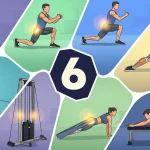Fit People, who here often feels tired, not just physically but mentally too?
If you’re a woman with a mountain of work, a mind full of distractions, and your body starting to feel unstable, maybe it’s time to get familiar with Pilates.
It’s not just a trend on TikTok or the routine of celebrities. Pilates is more than just a healthy lifestyle—it’s a gentle movement that reaches your body’s core. Yes, the parts you often neglect: your core muscles and inner balance.
Don’t get it wrong, Pilates is not yoga. But it’s also not a ‘light’ workout either. Pilates is the art of moving your body with full awareness, deep breathing techniques, and core muscle strength that’s often overlooked.
What Is Pilates and Why Is It Ideal for Women?
Pilates was first developed by Joseph Pilates, a German athlete who believed that the body, mind, and breath are one. Pilates emphasizes posture, balance, stability, and movement control.
For those who don’t like high-impact exercises, are in recovery, or have recently given birth—Pilates is a gentle but powerful form of exercise. Many physiotherapists even recommend Pilates for injury recovery and pelvic issues.
In fact, a study from Science Direct mentions that Pilates significantly increases core muscle strength, flexibility, and body control after 8 weeks of regular training.
10 Benefits of Pilates for Women
- Strengthens the Pelvic Muscles
The pelvic muscles are like the ‘hidden foundation’ of a woman’s body. When these foundations are strong, you’ll have better control over urination, won’t leak when you sneeze, and may even experience improved sexual satisfaction.
Reference: Cleveland Clinic – Pelvic Floor Exercises
- Improves Posture and Reduces Back Pain
Do you sit all day working in front of a laptop? Pilates helps keep your spine upright and flexible.
A study in PubMed (2014) shows that patients with chronic lower back pain experienced a significant reduction in pain after 6 weeks of Pilates.
- Shapes Muscles Without Making Them ‘Big’
Pilates helps your muscles become ‘long,’ lean, and symmetrical. Not big like a bodybuilder, but more like “fit & lean.”
- Improves Flexibility
Pilates movements help release tight muscles. You’ll start to feel your body becoming ‘more spacious.’
- Improves Breathing and Mental Calmness
The deep breathing technique in Pilates helps you become more mindful. It’s not just about the physical, but how your body and mind synchronize.
- Maintains Balance and Coordination
Pilates teaches you to move from your body’s center. This is especially beneficial for women over 30 who may begin to lose their balance.
- Increases Body Awareness
After a few weeks of training, you’ll become more aware of your posture, how you walk, and even how you sleep.
- Reduces Risk of Injury
Because Pilates focuses on functional movements and stabilizing muscles, it’s a safe option for beginners.
- Safe for Pregnant Women or Postpartum Women
Many believe that exercising during pregnancy is dangerous. On the contrary, with proper guidance, Pilates can be one of the safest and most beneficial exercises for pregnant and postpartum women.
Why is it safe? Because Pilates focuses on the core muscles, posture, and breathing—three important components needed during pregnancy and recovery after childbirth.
For pregnant women, Pilates can help:
- Reduce lower back and hip pain.
- Improve balance as the body begins to change shape.
- Help with breath control and relaxation—very useful as you approach labor.
For postpartum women, Pilates plays a significant role in:
- Restoring abdominal and pelvic floor muscle strength.
- Improving posture due to breastfeeding or carrying a baby.
- Reducing symptoms of diastasis recti (separation of abdominal muscles after pregnancy).
A study from the Journal of Bodywork and Movement Therapies (2018) showed that Pilates during the second and third trimesters of pregnancy can improve pelvic muscle control and reduce the risk of incontinence after childbirth.
Another study from the Journal of Physical Therapy Science (2015) found that postpartum women who practiced Pilates regularly experienced increased pelvic floor muscle strength and a significant reduction in waist circumference and lower back pain after 8 weeks of the program.
But, remember Fit People: 💡 Not all Pilates movements are safe for all stages of pregnancy. Make sure you follow a prenatal/postnatal Pilates class with a certified instructor and get clearance from your obstetrician.
- Connects the Body and Mind
When you start feeling overwhelmed by your routine and life pressures, Pilates can be a “self-care” space to reconnect with yourself.
Tips for Starting Pilates if You’re a Beginner
- Start with a beginner class—online is fine as long as it’s from a certified instructor.
- Frequency: 2–3 times a week is sufficient.
- Use a comfortable mat and wear comfortable clothes.
- Don’t rush for results, Pilates is a process, not a number target.
Can Pilates Help with Weight Loss?
Yes. But don’t misunderstand, Pilates isn’t cardio, it works in a more elegant way. When your muscles are more active and your posture improves, your metabolism will increase.
According to Harvard Medical School, a 70 kg person can burn 175 calories in 30 minutes of light Pilates, and up to 250 calories for high-intensity Pilates.
Conclusion: It’s Not Just About a Flat Stomach, But More About Connecting with Yourself
Fit People, Pilates isn’t just a ‘women’s exercise’ as it’s often underestimated. Instead, Pilates teaches us how to listen to our bodies, strengthen from within, and stay balanced amid life’s pressures.
Whether you’re a housewife, office worker, student, or a self-love warrior—Pilates is worth trying. Not just to look good in the mirror, but to feel stronger, calmer, and more confident.
💬 So, what do you think? Are you interested in starting a Pilates class this week? Yuk, make this part of your healthy life with Focus Fit!





